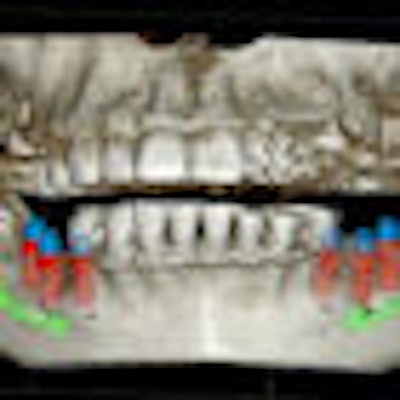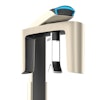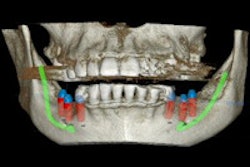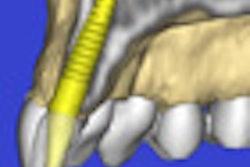
Adjusting the angle of the mandible during postimplant imaging using cone-beam CT (CBCT) can reduce the exposure time and related dose by a factor of four without decreasing the image quality, according to a new study in the European Journal of Radiology (December 2011, Vol. 80:3, pp. e389-e393).
Dental implants have been a driving force in the adoption of cone-beam CT in dentistry, given the advantages CBCT brings to dental implant treatment planning. But this same imaging modality cannot be used for postoperative validation and follow-up because of the imaging artifacts that occur with metal implants, according to the study authors, from the University of Basel and GKSS Research Center.
For this study, they wanted to examine how a CBCT operator could reduce the artifacts caused by standard titanium dental implants. They hypothesized that the tilting of the head could significantly reduce these artifacts.
"The effect should become especially clear for patients with multiple implants because the tilting can prevent the overlapping of the highly x-ray absorbing materials in the projections to be recorded," they wrote.
Using the mandible of a five-month old pig containing two titanium implants, the researchers took a series of CBCT images (3D Accuitomo 60, J. Morita), varying the accelerating voltage, beam current, starting rotation angle of the mandible in the source-detector plan, and tilt angles of the jaw with respect to the source-detector plane.
To determine the influence of the mandible position with respect to the source and detection unit, the specimen was manually rotated to 0°, 30°, 45°, and 90° around the implant's axis and tilted in the frontal and sagittal planes by -14.5°, -9.8°, -5.2°, 0°, 5.2°, 9.8°, and 14.5°.
After comparing these images with microcomputed tomography images, the researchers found that tilting the head by "moderate angles" -- the optimum being about 14° -- can improve the 3D data quality by a factor of two while reducing the dose to the patient by a factor of four.
"The comparison of 14-degree jaw tilting with respect to the currently recommended arrangement in plane with the teeth demonstrates that the applied exposure time and the related dose can be reduced by a factor of four without decreasing the image quality," the researchers wrote. "Tilting the jaw to reduce the overlap of highly x-ray absorbing implants and hard tissues significantly reduces the related artifacts and thus contributes towards postoperative imaging for validation and follow-up."
The study authors offer a simple solution to help reduce artifacts arising from existing implants, according to Allan Farman, BDS, MBA, PhD, DSc, a professor of radiology and imaging science at the University of Louisville in Kentucky and president of the American Academy of Oral and Maxillofacial Radiology.
"While the main use for cone-beam CT is in implant planning before placement, and the utility of cone-beam CT for postplacement evaluation of implants can be stymied by issues related to beam-hardening artifact, there are situations where a person needs further implants to be placed when existing implants are in place," he wrote in an email to DrBicuspid.com.
Future research should focus on the development of simple approaches to allow the operator of the cone-beam CT system to select the optimal tilt of the patient's head with respect to the source-detector plane, the researchers concluded.



















